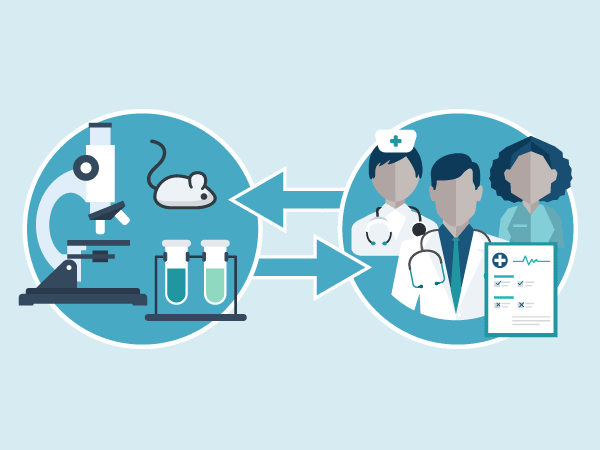
Bringing the Investigational Breast Cancer Drug Endoxifen from Bench to Bedside with NCI Support
August 31, 2017, by Matthew Goetz, M.D.
Many stories of successful cancer research follow a familiar arc: one of curiosity, iteration, collaboration, and persistence. The development of endoxifen, an investigational drug for breast cancer, is no different.
Like many research advances, the endoxifen story started with intriguing basic research findings that the research community continuously expanded on, eventually leading to clinical trials.
But this progress, and that of many other cancer research projects, was dependent on a critical component: endoxifen’s development would not have been possible without the support of NCI, as well as other government, nonprofit, and philanthropic organizations.
The endoxifen story began in the early-2000s with genetic studies of women with breast cancer who were treated with the drug tamoxifen (Nolvadex®). The plot has progressed through 2017, with promising results from an early-phase clinical trial of endoxifenpublished just yesterday and a phase II trial that is nearing completion.
Learning from Tamoxifen
Tamoxifen blocks breast cancer cell growth by preventing estrogen from binding to estrogen receptors (ERs). Many women with ER-positive breast cancer are treated with tamoxifen, and it’s estimated that the treatment has saved the lives of half a million women around the world.
But the efficacy of tamoxifen treatment varies and the drug does not work at all for about one-third of women with ER-positive breast cancer.
There likely are several reasons for this variability, and more than a decade ago, our research team at the Mayo Clinic hypothesized that one contributing factor may be how tamoxifen is processed in the body.
Tamoxifen binds only weakly to ERs, but can undergo a processing step inside the body to gain more potent anticancer activity. This step happens in the liver, where a series of enzymes, including one called CYP2D6, modifies tamoxifen to create other compounds. Two of these compounds—endoxifen and 4-hydroxy tamoxifen—inhibit estrogen up to 100 times more strongly than tamoxifen.
More than 100 common genetic alterations, called polymorphisms, in the CYP2D6 gene have been identified, and some of these alterations reduce CYP2D6’s enzyme activity. At the time our team began this research project, however, the impact of these genetic alterations on tamoxifen’s efficacy was unknown.
At that time, a research group led by David Flockhart, M.D., Ph.D., at Indiana University demonstrated that, among tamoxifen-treated women, those with low CYP2D6 activity—due to having a low-activity polymorphism or taking medications that block the enzyme—had lower levels of endoxifen in their blood compared with women with normal enzyme activity.
In 2005, with funding from an NCI grant, we collaborated with Dr. Flockhart’s group to analyze CYP2D6 polymorphisms in 223 women who had previously participated in an NCI-funded trial of tamoxifen. We found that patients with polymorphisms that lower CYP2D6 activity were more likely to relapse after tamoxifen treatment than patients with normal CYP2D6 activity.
With additional funding from NCI, we verified these findings in a second study of 1,325 women with breast cancer and a meta-analysis within the International Tamoxifen Pharmacogenomics Consortium.
We later discovered that endoxifen is critical for tamoxifen’s anticancer effects. In our lab experiments, for example, higher endoxifen concentrations (like those achieved in patients with high CYP2D6 activity) resulted in greater inhibition of breast cancer cell growth than low endoxifen concentrations (such as those observed in patients with low CYP2D6 activity).
Similarly, a separate group of investigators found that endoxifen halted the growth in five of the six breast cancer cell lines in the NCI-60 Human Tumor Cell Lines Screen. They found that endoxifen also slowed the growth of human breast cancer tumors in mice.
With this evidence, it became clear that tamoxifen treatment may be less effective for some women with low CYP2D6 activity simply because they produce less endoxifen. So, we thought, what if we could bypass CYP2D6 altogether by treating patients with endoxifen instead of tamoxifen?
To explore this idea, several members of the Mayo team performed experiments in lab animals to determine endoxifen’s pharmacokinetics—that is, how the drug is absorbed, distributed, and excreted. Endoxifen had a good profile by these measures, boosting its potential as a drug candidate.
For many of these preclinical studies, our team was supported by a Specialized Programs of Research Excellence (SPORE) grant, an NCI program that is designed to rapidly translate basic science discoveries into clinical applications. Igor Kuzmin, Ph.D., a program director in NCI’s Translational Research Program who manages the Mayo Clinic’s breast cancer SPORE, helped guide our endoxifen project from a small idea into a potential drug candidate.
Transitioning Endoxifen to Clinical Trials
Our next step was to develop endoxifen into a drug that could be administered to humans. But because its chemical structure was already public knowledge, there was limited interest in its drug development by pharmaceutical companies.
NCI, however, was in a position to step in again. As a part of its broad mission to bolster cancer research, NCI is uniquely qualified to develop promising new treatments or drugs that have limited potential for commercialization.
The institute recognized the potential of endoxifen to fill an important niche in the treatment of breast cancer, and with the help of NCI’s Developmental Therapeutics Program, led by Jerry Collins, Ph.D., endoxifen was formulated and synthesized for human treatment. Together, Mayo and NCI researchers further evaluated the safety of endoxifen in larger, more robust laboratory studies.
With promising results from these preclinical studies, NCI filed an Investigational New Drug application for endoxifen with the Food and Drug Administration (FDA) so that clinical trials could begin.
Through NCI’s Cancer Therapy Evaluation Program and clinical trials program, Mayo Clinic and NCI launched the first phase I trials of endoxifen in 2011 in women with metastatic breast cancer whose tumors had progressed following treatment with aromatase inhibitors and tamoxifen.
In one of the trials, we achieved the major goal of attaining the desired concentration of endoxifen independent of patients’ CYP2D6 activity. In addition, we observed encouraging antitumor activity, including in women whose tumors had progressed on tamoxifen, aromatase inhibitors, and the estrogen receptor inhibitor fulvestrant (Faslodex®).
In 2015, we initiated a randomized phase II trial comparing how well endoxifen and tamoxifen work in women with breast cancer, with results expected in early 2018. The trial is sponsored by NCI’s Cancer Therapy Evaluation Program and is conducted by the Alliance for Clinical Trials in Oncology, an NCI-funded clinical trials group.
A Needed Treatment Option
There is a major need for a better treatment option for the 5% to 20% of women diagnosed annually with ER-positive breast cancer for whom tamoxifen is ineffective, and direct endoxifen treatment may address that need.
If endoxifen shows promise in these trials, NCI could collaborate with an industry partner to manufacture it on a large scale and possibly move the investigational drug into the larger trials needed for FDA approval. If approved, a genetic test could potentially identify patients who are most (and least) likely to benefit from tamoxifen or endoxifen treatment.
It’s not yet clear how this endoxifen story will end. Drug development is costly and time consuming, and there’s no way to know if a drug will benefit patients until it is rigorously tested in multiple clinical trials.
What is clear, however, is that without the commitment and collaborative spirit of the Mayo team—including James Ingle, M.D., Matthew Ames, Ph.D., Joel Reid, Ph.D., Thomas Spelsberg, Ph.D., and John Hawse, Ph.D.—and NCI’s continuous support, this potentially promising therapy might never have been developed. I’m thankful to have come this far with our story, and am hopeful that our efforts will ultimately lead to beneficial results for patients.


No hay comentarios:
Publicar un comentario